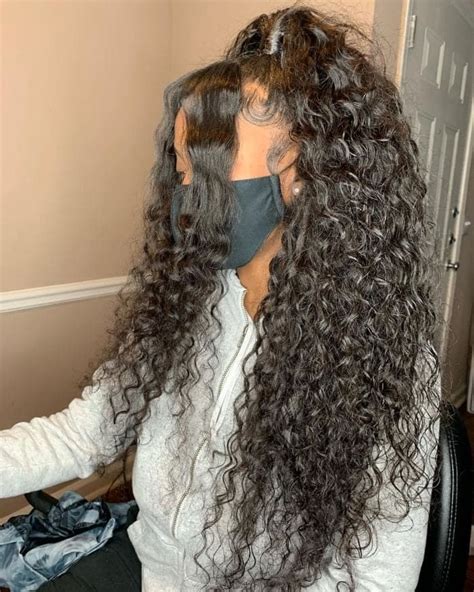Introduction
Hair extensions have become increasingly popular in recent years, with sew-in hair weaving being a versatile and long-lasting option. In this guide, we will delve into the world of sew-in hair, exploring its benefits, techniques, types, maintenance, and more.

Understanding Hair Weaves
Hair weaving involves adding hair extensions to your natural hair to create volume, length, or color. Sew-in weaves are attached by hand-sewing the extensions to small cornrows or braids on the scalp. They provide a secure and seamless blend with natural hair.
Benefits of Sew-In Hair
- Length and Volume: Sew-in weaves can instantly add significant length and volume to your hair, transforming a bob into long locks or adding fullness to thin hair.
- Versatile Styling: The extensions can be styled in various ways, including curls, waves, or braids, allowing endless styling options.
- Long-Lasting: Sew-in weaves typically last 6-8 weeks with proper care, making them a longer-term investment compared to clip-in or tape-in extensions.
- Protection: The extensions can help protect natural hair from heat damage, environmental factors, and over-styling.
- Hair Growth: Some sew-in weaves leave your roots exposed, allowing natural hair to grow underneath.
Types of Sew-In Hair
There are numerous types of hair used for sew-in weaves, including:
- Human Hair: The most premium option, providing a natural look and feel.
- Synthetic Hair: More affordable than human hair, but may be less durable.
- Remy Hair: Human hair with the cuticles intact, ensuring the same growth direction and less tangling.
- Double Drawn Hair: Hair with a consistent thickness from root to end, resulting in a fuller appearance.
Techniques for Sew-In Hair Weaves
Two primary techniques are used for sew-in hair weaving:
- Machine Sew-In: The extensions are attached using a sewing machine, providing precise and consistent stitching.
- Hand Sew-In: The extensions are sewn in by hand, allowing for more customization and a tighter hold.
Choosing the Right Hair for You
When selecting sew-in hair, consider the following factors:
- Hair Type: Match the texture and quality of your natural hair to ensure a seamless blend.
- Length and Volume: Determine the desired length and volume you want to achieve.
- Budget: Hair extensions can range in price, so set a budget before making a purchase.
- Hair Care: Inquire about the specific hair care requirements of the extensions.
Installation and Maintenance
Sew-in hair weaves require professional installation by a licensed hairstylist. To maintain the extensions:
- Wash and Condition: Regularly wash and condition the hair using products specifically designed for extensions.
- Detangle: Use a wide-tooth comb to detangle the hair, starting from the ends and working your way up.
- Moisturize: Apply conditioning treatments or hair oils to keep the hair hydrated and prevent breakage.
- Avoid Heat: Limit heat styling to protect the extensions and prevent damage.
- Get Regular Salon Visits: Schedule regular salon appointments for professional maintenance, including tightening, washing, and conditioning.
Pros and Cons of Hair Weaves
Pros:
- Transforms hair length and volume
- Versatile styling options
- Long-lasting
- Protects natural hair
- Can promote hair growth
Cons:
- Requires professional installation
- Can be time-consuming to install
- Regular maintenance is necessary
- Not suitable for all hair types or scalp conditions
Cost of Sew-In Hair
The cost of sew-in hair weaves varies depending on the type of hair, length, volume, technique used, and salon location. Typically, expect to pay between $200-$1,500 for a full head of sew-in extensions.
FAQs About Sew-In Hair
- Can I wash my hair with extensions? Yes, but use sulfate-free shampoo and conditioners made for extensions.
- How often should I get my extensions tightened? Every 2-4 weeks, depending on your hair growth and styling habits.
- Can I use heat on my extensions? Limit heat styling as it can damage the hair; use a heat protectant spray before styling.
- How long do sew-in weaves last? Typically 6-8 weeks with proper care.
- What are the risks of sew-in weaves? Tension on the scalp, hair breakage, or scalp irritation if not installed properly.
Conclusion
Sew-in hair weaves offer a transformative solution for those seeking length, volume, and versatile styling options. With proper care and maintenance, sew-in extensions can provide a long-lasting and beautiful addition to your hair. By considering the factors discussed in this guide, you can make an informed decision about whether sew-in hair weaves are right for you and embark on a journey towards stunning hair transformations.
Additional Tables
Table 1: Types and Sources of Sew-In Hair
| Type | Source |
|---|---|
| Human Hair | Human donors |
| Synthetic Hair | Artificial fibers |
| Remy Hair | Human hair with intact cuticles |
| Double Drawn Hair | Human hair with consistent thickness |
Table 2: Hair Length and Volume Options
| Length | Volume |
|---|---|
| Short (6-12 inches) | Thin or medium |
| Medium (14-20 inches) | Medium or thick |
| Long (22-30 inches) | Thick or extra thick |
Table 3: Cost of Sew-In Hair Weaves
| Hair Type | Length | Volume | Cost Range |
|---|---|---|---|
| Human Hair | 16 inches | Medium | $400-$600 |
| Synthetic Hair | 20 inches | Thin | $150-$300 |
| Remy Hair | 24 inches | Thick | $600-$1,000 |
| Double Drawn Hair | 30 inches | Extra Thick | $1,000-$1,500 |
Table 4: Pros and Cons of Sew-In Hair Techniques
| Technique | Pros | Cons |
|---|---|---|
| Machine Sew-In | Precise and consistent stitching | May be bulky or uncomfortable |
| Hand Sew-In | More customizable and tighter hold | Requires more time and skill |
